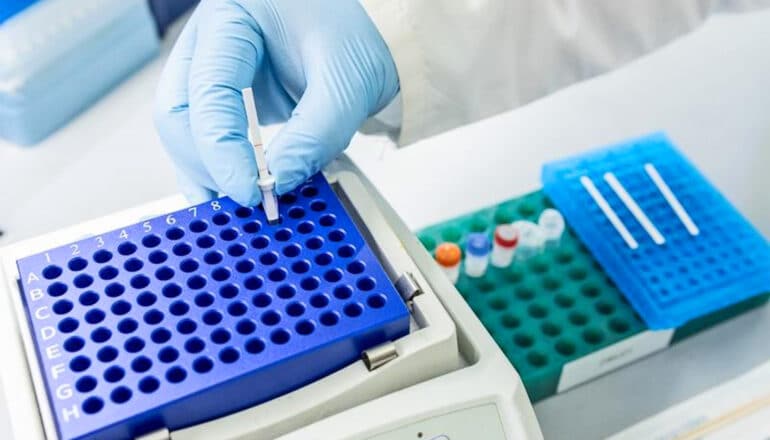New test could make tuberculosis screening way simpler
- New tuberculosis test uses CRISPR technology to detect TB from simple tongue swabs, offering a potential breakthrough for easier community-based screenings.
- The current sputum testing method is difficult and unfeasible in about 25% of symptomatic cases and nearly 90% of asymptomatic cases, leading to an estimated 4 million undiagnosed tuberculosis cases annually.
- The new test has shown high sensitivity in detecting TB in various samples, including respiratory, pediatric stool, adult spinal fluid, and tongue swabs, with detection rates ranging from 56% to 93%.
- The test is painless, easy to collect, and doesn’t require trained medical staff, making it accessible for large-scale screenings in low-resource communities.
- The study represents significant progress towards developing non-sputum based detection methods and outlines a practical pathway for fighting TB: screen widely, confirm quickly at the point of care, and connect positive results to effective treatment.

Researchers have developed an enhanced CRISPR-based tuberculosis test that works with a simple tongue swab.
It’s a potential breakthrough that could allow easier, community-based screenings for the world’s deadliest infectious disease.
Current TB tests rely on sputum, mucus collected from the lungs and lower respiratory system. While rich in TB bacteria required for testing, collecting sputum is difficult, making it inefficient for large-scale community testing.
Sputum testing is also unfeasible in about 25% of symptomatic cases and nearly 90% of asymptomatic cases, a gap which contributes to an estimated 4 million tuberculosis cases going undiagnosed annually.
In a study in Nature Communications, researchers worked to address that gap by refining a previously developed CRISPR-based assay to better detect TB in samples with very low levels of bacteria, such as stool, spinal fluid and tongue swabs.
Clinical testing showed markedly enhanced detection of TB in tongue swabs over traditional testing (74% compared to 56%).
The test also showed high sensitivity in detecting TB in respiratory (93%), pediatric stool (83%) and adult spinal fluid samples (93%). With children, HIV patients and those with extrapulmonary TB unable to produce sputum, the research marks a significant step forward toward offering effective diagnoses via a variety of samples.
“More than 10 million people worldwide fall ill with tuberculosis every year, but 40% of those cases are considered missing as people go undiagnosed,” says corresponding author Tony Hu, a chair in biotechnology innovation and director of the Tulane University Center for Cellular and Molecular Diagnostics.
“To find those missing cases, testing needs to be less invasive and more accessible to reach as many people as possible who may not otherwise be tested.”
Lead author Zhen Huang, an assistant professor at Tulane University School of Medicine, says developing a viable tuberculosis tongue swab test could transform testing in low-resource communities.
“Tongue swabs are painless, easy to collect, and don’t require trained medical staff,” Huang says. “That opens the door to large-scale screenings.”
The new CRISPR method, called the ActCRISPR-TB, increases amplification and detection of genetic signals from TB bacteria DNA and offers a rapid, streamlined approach that can return a diagnosis in under an hour.
To administer the test without need for a lab or trained medical staff, researchers developed a “one pot” approach. Like a COVID-19 test, a swabbed sample is added to a tube pre-loaded with a test strip and reagent. That tube is incubated, and after 45 minutes, colored bands on the strip will indicate presence of an infection.
While there is a clear need for developing non-sputum based detection methods, clinical testing also showed the test to be faster and more accurate than traditional tests when testing for TB in sputum nucleic acid.
The study marks the latest step in Hu’s effort to move TB testing out of the lab and into the community. In addition to showing TB can be detected from simple samples beyond sputum, Hu’s lab has also developed rapid tests that deliver results in less than an hour on portable devices, one the size of a smartphone and another that requires no electricity. His team has also used artificial intelligence to flag drug resistance so patients get the right medicines faster. Together, these advances outline a practical pathway for fighting TB: screen widely, confirm quickly at the point of care, and connect positive results to effective treatment.
While more research and development is needed, Hu and Huang says this study represents significant progress.
“If we want to end TB, we need tools that work outside the lab and in the communities where the disease spreads,” Hu says.
Source: Tulane University
The post New test could make tuberculosis screening way simpler appeared first on Futurity.
